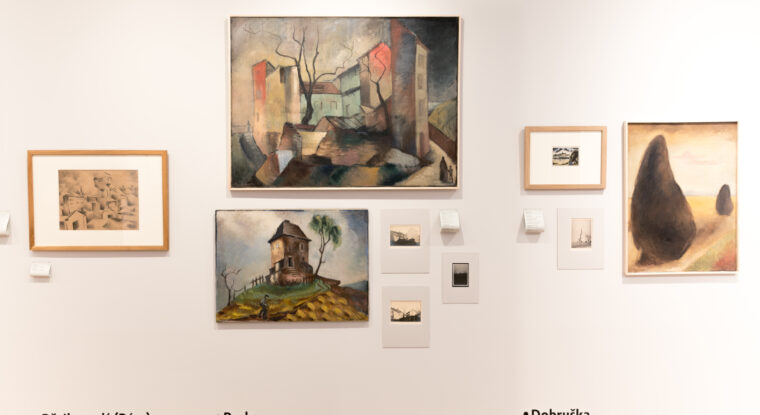The exhibition of works by Věra Jičínská presents key aspects of the oeuvre of this unjustly overlooked figure of Czech modern art. The selection of paintings, pastels, drawings, prints, and little-known photographs outlines the evolution of Jičínská’s work during the interwar era, when she studied, worked, or exhibited in Brno, Munich, Prague, Paris, Brittany, Pécs, and Dobruška. But the exhibition also looks at her work in the field of applied art, in which she was active after the Second World War.
Jičínská exemplified many of the attributes of the modern woman: She rebelled against paternal authority by leaving to study and work in the world, she established her financial independence, she smoked, she traveled, and by her short hair she demonstrated her freedom and independence. She was a flâneuse of the modern metropolis, and in the 1930s her passion for observation culminated in newspaper and magazine articles and extensive photographic documentation of the world around her. And yet, like many other women of her generation, she was repeatedly reminded by family, society, and critics that women’s role in life was first and foremost associated with motherhood, and that the legitimization of women’s art was bound to this aspect of womanhood. For a long time, she defied this prejudiced viewpoint by stubbornly studying and metamorphosing Cubism, Purism, and Neoclassicism, by seeking out subjects that had previously been the domain of men (including sensual paintings of female nudes), by traveling to “exotic” places, through expressive brushwork, and by abstracting visible reality. She also took the daring step, at age fifty, to set out on the previously unexplored path of designer.
The exhibition was supported by the Ministry of Culture of the Czech Republic and the Statutory City of Hradec Králové.

Left: Věra Jičínská, PARISIAN ROOFS (1923-1924); VIEW FROM MY STUDIO (1925) Middle: EIFFEL TOWER (1927); VIEW FROM MY PARISIAN STUDIO (1927) Right: FROM EDINBURGH (1926); LONDON (1926)

Left: Věra Jičínská, PÉCS (1926) Middle: VANISHED CORNER IN MORÁN (1932-1934); GLASSMAKER IN TROJA (1931); UNDER THE SLAVS (1934); GLASSMAKER IN TROJA (1934) Right: DOBRUŠKA (1942); ON THE WAY FROM DOBRUŠKA TO OPOČNO (1933); MEADOW | EVENING IN THE MEADOW (1932)

Left: Věra Jičínská, STANDING FEMALE NUDE (1926) Middle: LYDIA WISIAKOVA (1929) Right: FEMALE NUDE IN THE MIRROR (1929)

Left: Věra Jičínská, NUDE OF DANA (1953) Middle: DANA PAINTING (1958) Right: DANA GÖRNER, NUDE SELF-PORTRAIT (1958)

Left: Věra Jičínská, PORTRAIT OF A MULATTO WOMAN (1928); Middle: BLACK WOMAN WITH CHILD (1928); Right: BLACK WOMAN (1927)

From left to right: Carved wooden mask; Colored mask/reliquary with figurative base (Africa, undated); Postcards with motifs of Mexican masks from the collection of Věra Jičínská.

Left: Věra Jičínská, DANCER IN TRADITIONAL NATIONAL COSTUME (1926); PORTRAIT OF DANCER LYDIA WISIAK I. (1926); PORTRAIT OF DANCER LYDIA WISIAK (1930); LYDIA WISIAK – PORTRAIT (1927-1927)

Věra Jičínská, SMALL BOATS (1937); SMALL BOATS (PRAGUE) (1937); PRAGUE (FIRST WORK ON THE EXTENSION OF THE HOUSE NEAR RIEGER’S ORCHARD) (1937)

Left: Věra Jičínská, WINDOWS FROM THE BLOCK (1936); ST. NICHOLAS MARKET (1935) Middle: STAIRS (1936); FOG (1934) Right: MENHIRS (1936)